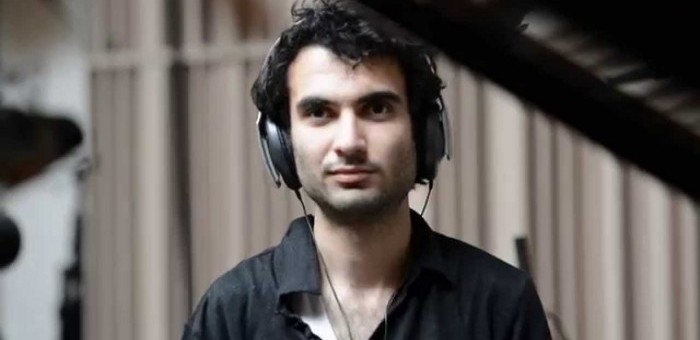Apr 2, 2024 12:59 PM
Saxophonist, Sonic Explorer Casey Benjamin Dies at 45
Casey Benjamin, the alto saxophonist, vocalist, keyboardist and producer who stamped his distinctive sounds on the…

Tigran Hamasyan performed at SubCultre in NYC on March 10. At points throughout his show, the pianist layered wordless vocals that sounded other-worldly in pitch.
(Photo: Courtesy of the artist)On the end of his five-city U.S. tour, pianist Tigran Hamasyan returned to New York (where he had lived briefly years ago) to take the stage at SubCulture for two exhilarating—and in turns mystical—solo sets on March 10.
He packed the house during the first show, and the line stretching up the stairs into the lobby and onto Bleecker Street in the East Village indicated that the second show would be equally as full. Not bad for an artist who swims in rivers separate from—though parallel to—mainstream jazz.
It probably has something to do with the fact that Hamasyan was born in Armenia, having returned to his homeland recently after years in New York and L.A. Still, given that he won the Thelonious Monk Institute 2006 piano competition as well as several other European awards, you’d think he’d be more widely known in the U.S. (granted, he’s a hero in Europe.) That didn’t matter to the young and diverse crowd that came to cheer and at times hoot the singularly styled Hamasyan.
The soon-to-turn 30-year-old is a unique jazz amalgamator, with strong influences including classical, hip-hop, heavy metal, electronica and Armenian folk music, which in pockets inform his surprising and exciting virtuosic and groove-oriented improvisations. His strongest asset is his melodicism, a dominating factor in his SubCulture show, in which he performed music from his latest album, An Ancient Observer, his sophomore recording for Nonesuch and his second solo launch.
Hamasyan opened with his back to the audience as he noodled on an electronic keyboard in lyrical fashion, church-like in its quiet, then scarred by electronica scrapes. As he did throughout the rest of the show, on “New Baroque 2,” he layered wordless vocals that at certain times sounded other-worldly in pitch.
With a one-note electronic bass note drone, he sat at the piano for the charged, classical-like “Fides Tua,” dipping his head almost to the keys for the gentle melodicism and then jolting straight up when he took his crowd-pleasing hard drive. The pattern of ascending energy continued through the show, as rhythmic contemplation burst into fired ecstasy on “The Cave Of Rebirth,” which contained a stretch that sounded vaguely as if he were backmasking (he wasn’t).
The highlight of the early set was the title track that started sober then galloped into a louder and faster dynamic, with left-hand eruptions balanced with right-hand lyricism and a stutter of chords with both hands. With all the changes, there was a sense of reverence in the tune. No swing, no intellectualism but lots of movement. His percussive rhythms danced into a rock beat over a speedy vocal scat, prompting the crowd to yelp at the end.
One of the key elements that enlightens his music is his exploration of ancient Armenian folk tunes, which are often reconfigured into metal-meets-jazz arrangements. That came to the fore on “Nairian Odyssey,” fueled by two Armenian melodies that calmed the pianist before he took off into a fingers-blurred journey with fluctuating speeds and McFerrin-like vocalese.
The song in particular was vibrant in a uniquely jazz way—safe for jazzophiles listening for something virtuosic but equally accessible to rockers looking for speedy rides. After another electronica interlude, Hamasyan ended with the whimsical “Markos And Markos,” which started with a playful piano skip developing into sharp-fingered vignettes taken at canter speed. Dreaminess and a dark hipness were in the mix as Hamasyan flew through different modes of expression. This awarded him with a standing ovation that resulted in the short but spiritually charged “Egyptian Poet.” He introduced the song by describing how it was inspired by a poem written in 2000 B.C.
“I found this book of a poetry collection at a used book store in Armenia where all the titles were like 30 cents a piece,” he told the crowd. “I was expecting poetry from the ancient Middle East or medieval Persia, but on the first page there was this poem. Funny thing is, what he was writing about is exactly what we‘re facing in the 21st century. Nothing has changed, except back then the people were more spiritual.”
This song was accordingly transcendent, Hamasyan’s way of capping the evening with a blessed “amen.” DB

Benjamin possessed a fluid, round sound on the alto saxophone, and he was often most recognizable by the layers of electronic effects that he put onto the instrument.
Apr 2, 2024 12:59 PM
Casey Benjamin, the alto saxophonist, vocalist, keyboardist and producer who stamped his distinctive sounds on the…

“He’s constructing intelligent musical sentences that connect seamlessly, which is the most important part of linear playing,” Charles McPherson said of alto saxophonist Sonny Red.
Feb 27, 2024 1:40 PM
“I might not have felt this way 30 to 40 years ago, but I’ve reached a point where I can hear value in what people…

Albert “Tootie” Heath (1935–2024) followed in the tradition of drummer Kenny Clarke, his idol.
Apr 5, 2024 10:28 AM
Albert “Tootie” Heath, a drummer of impeccable taste and time who was the youngest of three jazz-legend brothers…

“Both of us are quite grounded in the craft, the tradition and the harmonic sense,” Rosenwinkel said of his experience playing with Allen. “Yet I felt we shared something mystical as well.”
Mar 12, 2024 11:42 AM
“There are a few musicians you hear where, as somebody once said, the molecules in the room change. Geri was one of…

Henry Threadgill performs with Zooid at Big Ears in Knoxville, Tennessee.
Apr 9, 2024 11:30 AM
Big Ears, the annual four-day music celebration that first took place in 2009 in Knoxville, Tennessee, could well be…